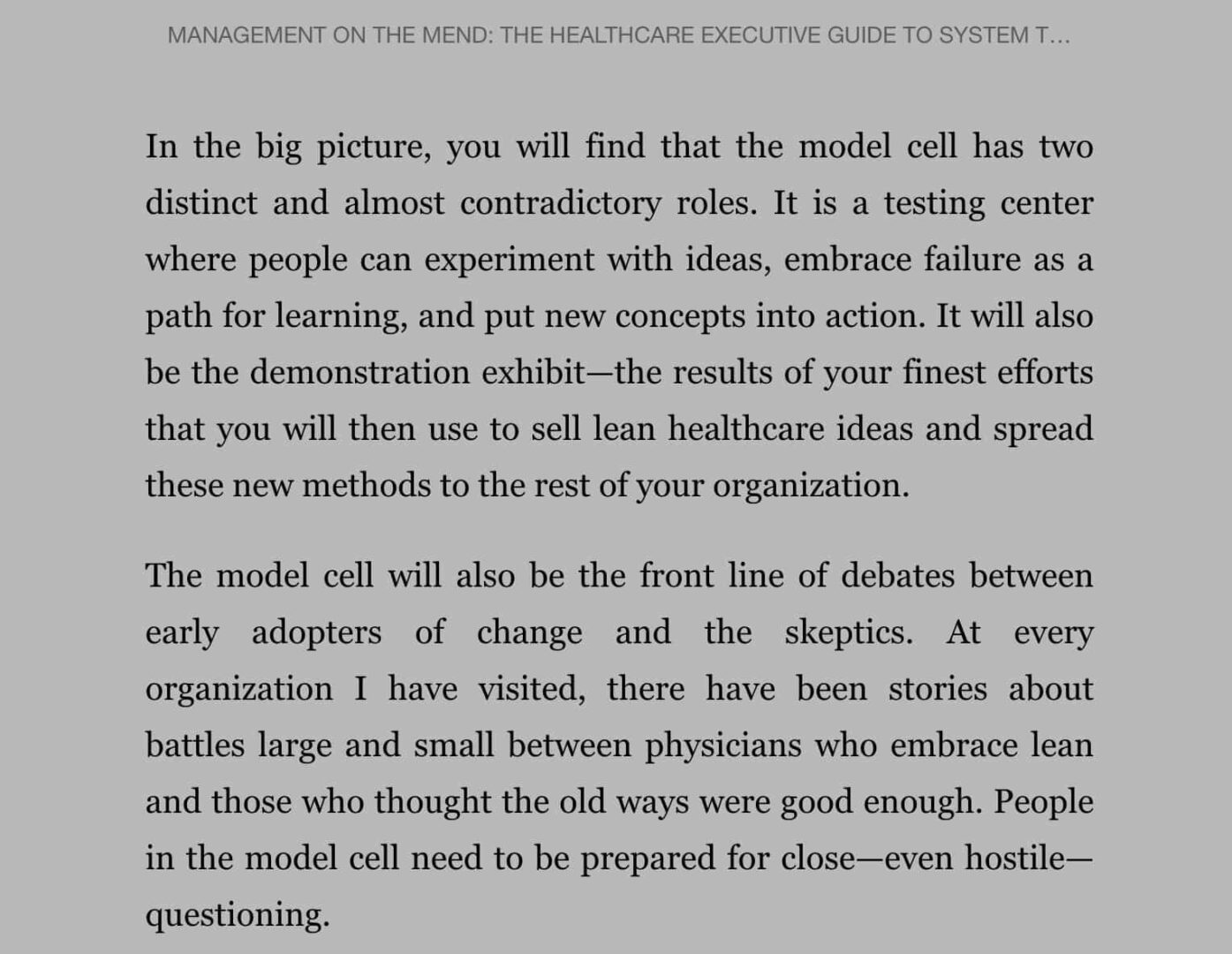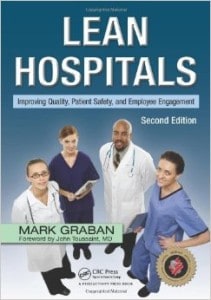tl;dr: In this post, Mark discusses the concept of “Model Lines” and “Model Cells” as strategies for Lean transformation. He outlines how these designated areas serve as experimental zones within an organization, allowing for the focused implementation and testing of Lean principles. Mark argues that such models can serve as catalysts for broader organizational change by demonstrating the effectiveness of Lean methods in real-world settings. The post emphasizes the importance of iterative learning and scaling successful practices to achieve a comprehensive Lean transformation.
There are any number of strategies or tactics that hospitals or health systems use when getting started with Lean.
These approaches and decisions include one or more of the following… should we…
- Train lots of employees and managers about Lean?
- Decide if we're using Lean or “Lean Six Sigma”?
- Formally certify managers and employees?
- Do lots of formal Rapid Improvement Events?
- Use “strategy deployment” from the top?
- Hire an outside consultant and/or an internal Lean leader or team?
There are pros and cons to each approach. The pros are “it might help” for each of those bullet points. The common cons include:
- Training people might lead to frustration or a lack of action if we're not changing the culture and the way we manage
- Six Sigma might overcomplicate things or the “Lean Sigma” training might not cover much about Lean
- Certifications might be a waste of time and money if, again, people aren't allowed to practice what they've learned
- A bunch of RIEs might be disconnected, too scattered, and not sustained
- Strategy deployment might be difficult to understand or appreciate if executives don't first understand the basics of PDSA and Lean
- An outside consultant or internal Lean people can't “make you Lean” – the transformation can't be delegated or outsourced
Obviously, those cons don't always happen, but they happen often enough and with that comes risk of “Lean failure.”
The Model Line
There's another approach that goes underappreciated, I think — the “model line” or “model cell” approach. It has nothing to do with fashion models. I don't like the term “cell” because it might make people think of a prison or a gulag. Then again, the word “line” might make people think of “assembly line medicine” in a negative way. Maybe “model area” is a better term? I'll think about that as I work on the updated 3rd edition of my book Lean Hospitals.
Hear Mark read the post (subscribe to the podcast):
When I worked as a consultant for ValuMetrix Services (a part of Johnson & Johnson at the time), we used this model line approach with our clients. Let's say you're a multi-hospital health system. Is it realistic to expect that the entire health system is going to “get Lean” all at the same time? Do you have the coaching, training, and support resources to make that happen?
What if you have one of your hospital CEOs who is most enthusiastic about Lean and most willing to learn and lead? You might start in that hospital, working to establish a Lean culture there first, as a model for the rest of the system.
But, then again, a single hospital is still a pretty big place. Can the entire hospital “get Lean” all at once? Probably not. You might spread yourselves too thin. Maybe you should start with one department or one value stream where, again, the leaders are begging to “go first.” You can choose to solve a problem that matters, such as emergency department patient flow – viewing that as a value stream, not a department project.
The model line becomes a demonstration site, a proof of concept, that shows real culture change and real results. You have to start somewhere. Otherwise, you run the risk of a diffuse effort being spread too thin, working for five years on building broad “capabilities,” accomplishing little in the process. THAT is how a Lean department gets kicked out – by not showing results.
John Toussaint on Model Cells
Dr. John Toussaint, CEO of the ThedaCare Center for Healthcare, has been writing and talking about this approach, which I'm very happy to see.
He wrote, for the LEI Lean Post site, this: “Transforming Healthcare is Complex, Start with a Model Cell.” He starts the piece:
“I've now visited over 130 healthcare organizations in 12 countries and seen many different approaches to lean transformation. What have I learned? If I were to begin another lean transformation today, in a healthcare organization or anywhere else, the first thing I'd do is work with my team to develop a model cell.
The model cell approach is best thought of as “an inch wide and a mile deep” (in contrast to an inch deep and a mile wide). We started our journey at Thedacare with this approach. In other words we did a lot of kaizen and a lot of value stream mapping. But in most cases our work was not tied to the important business goals of the organization. And since we didn't have any knowledge of the management system required to sustain improvement or build a continuous improvement culture, most of our early work was for naught. In the early days we joked that we did a lot of “drive by Kaizen,” which was actually detrimental to our transformation.”
John writes about this approach in his latest book Management on the Mend (read my blog post about my first thoughts about the book and listen to my podcast interview with him). We're going to do another podcast specifically on the “model cell” approach soon.
In the book, John lays out five guidelines for a model cell:
- Must be focused on a business problem that is important to the organization
- Model cell runs an inch wide and a mile deep (limited in scope to one unit or clinic)
- Create a new system based on standard work
- Tie the model cell work to True North
- This must involve senior leadership if at all possible
At ValuMetrix Services, we did a really good job on points 1, 2, and 3. Point 4 was difficult because many organizations don't have a clearly-defined True North. They have umpteen objectives and measures and initiatives, rather than have focus and clarity. Point 5 happened sometimes… but it depended on the organization and whether the executives thought they could delegate Lean or if they had to participate. Of course, participation is better.
Toussaint also adds:

I've been there for that questioning and hostility. “Lean won't work here” and “we're different” are points you have to discuss rather than ignore.
“Model Lines” in Lean Hospitals
In the first edition of Lean Hospitals, released in 2008, I wrote about the pitfalls of focusing too much on Rapid Improvement Events in Chapter 11 and I wrote about “Establishing a Model Line and a Roadmap.”
The text didn't change too much from 2008 to the 2nd edition in 2011, so I'll cite the 2nd edition with an excerpt below:
“Rather than trying to implement a Lean method (or set of methods) throughout the entire hospital, an effective approach is to establish a model line around one department (such as the pharmacy or a laboratory) or one particular patient pathway (such as patient flow starting at arrival to the ED). Creating a limited model line scope reduces the time required to implement a full set of Lean methods and management systems. Implementing Lean in a department of 100 people is far less intimidating than trying to spread the same ideas across 5,000 employees all at once.
The model line can be selected based on prioritizing a number of factors, including the needs assessment (which problems need solving?), current state assessment (what waste can be eliminated?), and readiness assessment (do the managers, staff, and physicians agree change is needed and possible?).
The senior leadership team may start with a plan or road map for implementing Lean beyond the initial department. Hospitals often plan their first two or three projects, based on the current view of goals and priorities. For example, in the first year of the Lean journey at a hospital, it might plan to complete two projects, for example, in the lab and in radiology, since each transformation project takes approximately 3 or 4 months.”
What do you think of the “model line” approach? Have you tried it, based on my book or John's work? What do you see as “pros and cons” of this approach, compared to other training-based or event-based models?
Please scroll down (or click) to post a comment. Connect with me on LinkedIn.
Let’s build a culture of continuous improvement and psychological safety—together. If you're a leader aiming for lasting change (not just more projects), I help organizations:
- Engage people at all levels in sustainable improvement
- Shift from fear of mistakes to learning from them
- Apply Lean thinking in practical, people-centered ways
Interested in coaching or a keynote talk? Let’s talk.
Join me for a Lean Healthcare Accelerator Trip to Japan! Learn More











Here is a Gemba Academy podcast that happened to be released recently on July 23, 2015:
GA 068 | The Model Line Approach with Lee Fried and Kris Box
The topics include:
Why organizations choose the model line approach (11:27)
The main challenges of this approach (13:44)
The balance of standard work and a model line (19:07)
Whether Kris and Lee ever use 3P (23:14)
How long model lines should operate (26:36)
Alternatives to a model line approach (29:53)
Hi Mark – I really enjoyed your post..thanks. It could be helpful (and timely) for us as we revise our approach and consider using a model line. Look forward to your upcoming podcast on the same topic.Keep up the great work…Jonathan
Comments are closed.